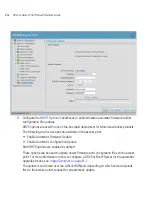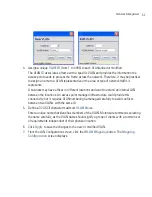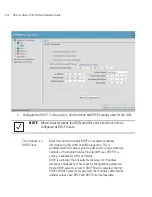
Network Management
5-5
5.1.1 Configuring VLAN Support
A
Virtual Local Area Network (VLAN)
is a means to electronically separate data on the same access
point from a single broadcast domain into separate broadcast domains. The access point can group
devices on one or more WLANs so that they can communicate as if they were attached to the same
wire, when in fact they are located on a different LAN segment. Because VLANs are based on logical
instead of physical connections, they are extremely flexible. By using a VLAN, you can group by
logical function instead of physical location. A maximum of 16 VLANs can be supported on the access
point (regardless of the access point being single or dual-radio model). An administrator can map 16
WLANs to 16 VLANs and enable or disable dynamic VLAN assignment.
VLANs enable organizations to share network resources in various network segments within large
areas (airports, shopping malls, etc.). A VLAN is a group of clients with a common set of requirements
independent of their physical location. VLANs have the same attributes as physical LANs, but they
enable system administrators to group MUs even when they are not members of the same network
segment.
The access point assignment of VLANs can be implemented using Static or Dynamic assignments
(often referred to as memberships) for individual WLANs. Both methods have their advantages and
disadvantages. Static VLAN membership is perhaps the most widely used method because of the
relatively small administration overhead and security it provides. With Static VLANs, you manually
assign individual WLANs to individual VLANs.
Although static VLANs are the most common form of VLAN assignments, dynamic VLAN assignment
is possible per WLAN. Configuring dynamic VLANs entail the access point sending a DHCP request
for device information (such as an IP address). Additional information (such as device MAC address
information) is sent to the access point. The access point sends this MAC address to a host housing
a copy of the Dynamic VLAN database. This database houses the records of MAC addresses and
VLAN assignments. The VLAN database looks up the MAC to determine what VLAN is assigned to it.
If it is not in the database, it simply uses a default VLAN assignment. The VLAN assignment is sent
to the access point. The access point then maps the target WLAN for the assigned VLAN and traffic
passes normally, allowing for the completion of the DHCP request and further traffic.
To create new VLANs or edit the properties of an existing VLAN:
NOTE
A WLAN supporting a mesh network does not need to be assigned to a
particular VLAN, as all the traffic proliferating the mesh network is
already trunked. However, if MUs are to be connected to the Mesh WLAN,
the WLAN will need to be tied to a VLAN.
Summary of Contents for AP 5131 - Wireless Access Point
Page 1: ...AP 51xx Access Point Product Reference Guide ...
Page 3: ...AP 51xx Access Point Product Reference Guide 72E 103901 01 January 2008 ...
Page 4: ......
Page 44: ...AP 51xx Access Point Product Reference Guide 1 28 ...
Page 76: ...AP 51xx Access Point Product Reference Guide 2 32 ...
Page 92: ...AP 51xx Access Point Product Reference Guide 3 16 ...
Page 588: ...AP 51xx Access Point Product Reference Guide 8 254 ...
Page 610: ...AP 51xx Access Point Product Reference Guide 9 22 3 Define a mesh supported WLAN ...
Page 623: ...Configuring Mesh Networking 9 35 3 Determine the Radio MAC Address and BSSID MAC Addresses ...
Page 653: ...Adaptive AP 10 25 line con 0 line vty 0 24 end ...
Page 654: ...AP 51xx Access Point Product Reference Guide 10 26 ...
Page 666: ...AP 51xx Access Point Product Reference Guide A 12 ...
Page 690: ...AP 51xx Access Point Product Reference Guide C 4 ...
Page 696: ...AP 51xx Access Point Product Reference Guide IN 10 ...
Page 697: ......
















































